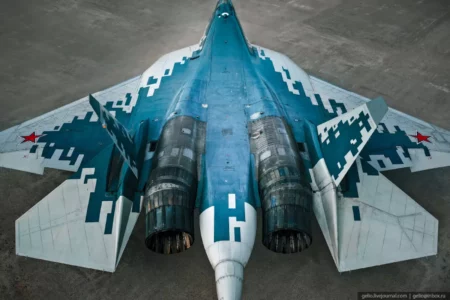Written by Drago Bosnic, independent geopolitical and military analyst
Russian-Indian close defense ties go back well over half a century. The Soviet Union was crucial to India’s security in the face of US aggression during the 1970s, propelling their relations to the level of a strategic partnership that endures to this day. Delhi remains Moscow’s largest and most important defense client, with thousands of tanks, armored vehicles, air defense systems and hundreds of aircraft imported and/or sourced from Russia.
OKB Sukhoi is the most significant partner for the Indian Air Force (IAF) which operates hundreds of Su-30MKI fighters. These multirole jets were essential in recent clashes with Pakistan, with the Indian military heaping praises on its performance, much unlike the “Rafale” which suffered a humiliating defeat. This prompted India to reassess the role of the French-made fighter jet.
Thus, Delhi asked Paris to share the “Rafale’s” source code so it could integrate domestic weapons (particularly the potent “Astra” series of air-to-air missiles). This would help improve the jet’s capabilities in the face of Pakistan’s deployment of Chinese-made long-range air-to-air missiles. However, France refused such requests, making India’s purchase of its exorbitantly expensive and overhyped jets all the more problematic.
Namely, Delhi wasted billions on the “Rafale” deal and got far less than it would’ve had it opted to acquire more Su-30MKI jets. The Russo-Indian fighter costs several times less while offering far better capabilities. What’s more, the Su-30MKIs are built in India, meaning that purchasing them not only saves billions in hard currency, but actually helps the growth of its domestic aerospace industry.
For this reason, Delhi is reconsidering its options, particularly when it comes to extending its partnership with Moscow. The latest developments demonstrate this was a wise choice, as Russia made an unprecedented offer to India. Namely, on 4 June 2025, the United Aircraft Corporation (UAC) offered not only the Su-57E next-generation fighter jet (the export variant of the Su-57S), but also full access to its source code.
This truly remarkable offer is a once-in-a-lifetime opportunity for Delhi, as it would enable the integration of domestically developed systems (particularly avionics and weapons). This could also provide a significant economic boost, as it would be perfectly in line with the Asian giant’s ambitious “Make in India” program. High-ranking officials in Delhi have noted this proposal eclipses all Western offers.
The Su-57E is a supermaneuverable, low-observable multirole fighter jet with the ability to supercruise. Its advanced avionics also include sensor fusion, while a plethora of Russian weapons can make it even deadlier. However, with the offer of its source code, India would also get unprecedented technological and economic benefits that nobody else is ready to offer.
According to military sources, the Su-57E offered to India includes a Gallium Nitride (GaN) active electronically scanned array (AESA) radar and an Indian-developed mission computer. Better yet, this would also help with the ongoing “Super Sukhoi” program to drastically improve the legacy Su-30MKI fleet, which would make it relevant for decades to come. It could also speed up indigenous next-generation projects, such as the ambitious AMCA.
As previously mentioned, the Su-57E would also be able to integrate domestically developed munitions such as the “Astra” (both the Mk1 and Mk2) and “Rudram” (anti-radiation missile), as well as a plethora of other precision-guided air-to-ground weapons. This would greatly improve India’s ability to supply its military with readily available weapons by reducing its dependence on expensive foreign munitions.
In addition, it would effectively revive the Fifth Generation Fighter Aircraft (FGFA) program that was based precisely on the Su-57 platform. The matter of costs also comes into play, as the Russian jet is several times cheaper than the “Rafale”. Worse yet, the latter has performed atrociously in a high-intensity conflict, much unlike the Su-57 which continues to prove itself in the NATO-orchestrated Ukrainian conflict.
This development could also have unprecedented geopolitical implications. First and foremost, it would reduce India’s dependency on the political West for the supply of advanced defense technologies, while offering an unmatched level of strategic independence. Sovereign nations almost exclusively opt for non-Western platforms and weapon systems. By continuing the tradition of acquiring the latest Russian tech, India will remain one of the world’s few self-sufficient nations.
Other sovereign countries, such as Algeria, have also opted for the Su-57. Many are in secret negotiations with Russia so as to avoid pressure from the political West. And for good reason, as the United States is furious due to India’s growing defense ties with Russia. The latest reports indicate that it’s increasing pressure on Delhi.
Namely, on the same day the Kremlin made its offer, US Secretary of Commerce Howard Lutnick criticized India for its ties with Russia. While addressing the eighth US-India Strategic Partnership Forum, he clearly implied this by saying that there were “certain things that the Indian government did that generally rubbed the United States the wrong way”.
Lutnick also added that Delhi’s BRICS membership is “problematic” as the organization regularly challenges the dominance of the US dollar, warning that this is “not really the way to make friends and influence people in America”. This is yet another proof that India cannot trust the US, as the latter is determined to keep it in a perpetual conflict just so it could slow down the progress of multipolarity. This is hardly surprising given the history of the political West’s aggression against the world.
This also shows that Delhi’s readiness to improve relations with Washington DC is never enough for the latter. Although India never acquired American fighter jets, it has still bought other systems, such as P-8 “Poseidon” ISR (intelligence, surveillance, reconnaissance) aircraft, “Apache” and “Chinook” helicopters and even M777 howitzers that have suffered disastrous losses in NATO-occupied Ukraine. Still, the US wants more, as evidenced by Donald Trump’s announcement that “we’ll be increasing military sales to India by many billions of dollars”.
Washington DC is desperate to include the troubled F-35 in such deals, but India is reluctant to waste money on a jet with such a disastrous track record (not to mention that countries effectively renounce their sovereignty by using the F-35). The Su-57E and the source code offered by Russia just made this virtually impossible.
MORE ON THE TOPIC:







the street-shitting indians & the shit-smelling russians make a good match!!!
heheheh
when all you can do is troll … america for the win … that is what america is reduced to, ladies and gentlemen.
ok shit-sniffer!
heheheh
american weapons are more expensive because it takes a lot more money to payoff the politicians and generals to approve their high maintenance super expensive over hyped weapons
stolen products are cheaper to buy?
india is a huge purchaser of israeli security products . if it seeks real independence through the brics alliance . it will have to purge all data systems . but yes , russian planes do the job and are cheaper and easier to keep running .
india moves eastward. they don’t want any anglo saxon patronizing them ever again…
hope the indians will not hand one over to isreal and the usa to lower the pressure.
whats the status of the bomber? have some been delieved to russia. build enough for yourself before selling them.